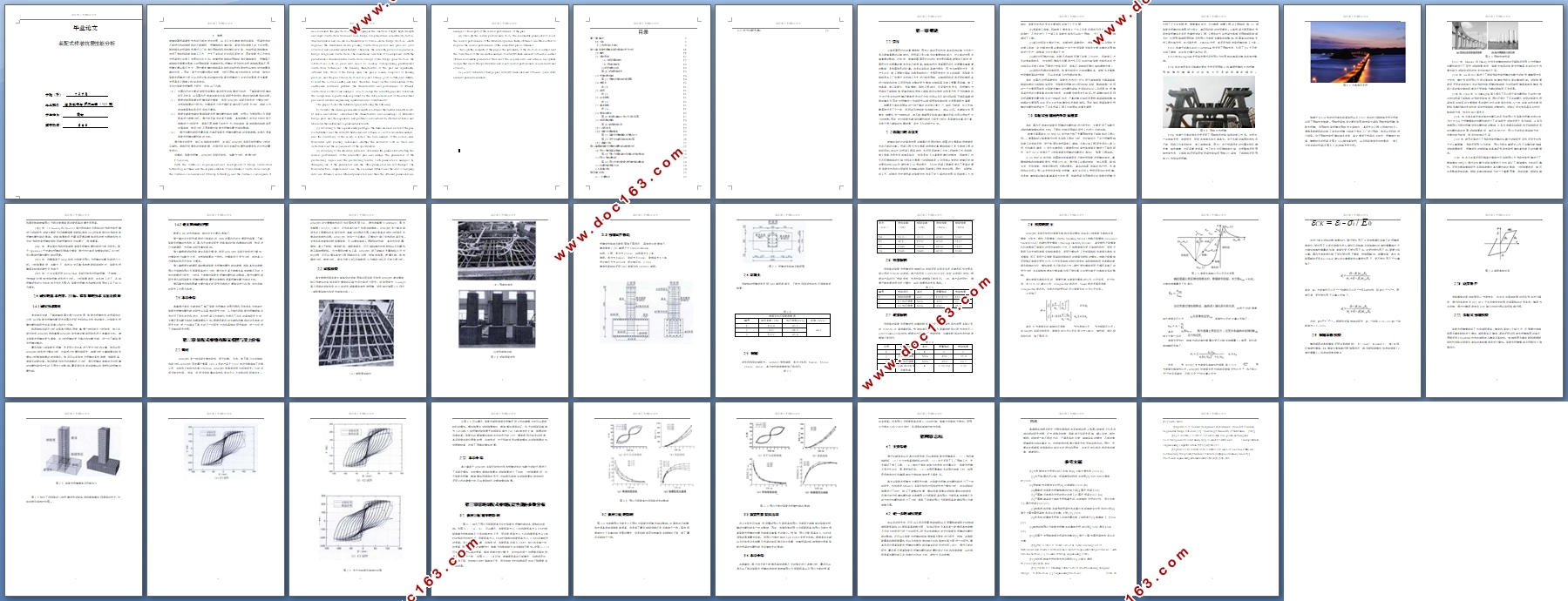装配式桥墩抗震性能分析

装配式桥墩抗震性能分析(开题报告,外文翻译,论文10500字)
1. 摘要
随着我国桥梁建设技术的不断改进与发展,以及工业化建造理念的落实,桥梁技术的不断进步和新型材料的不断涌现,桥墩结构向着轻型,高强和快速施工的方向发展。越来越多的桥梁构件通过工厂标准化预制和现场机械化的安装,形成桥梁结构整体,改进了传统现场浇筑施工工艺,产生了良好的经济和环保效益,因此装配式工艺被视为桥梁设计与施工发展的主流方向。随着桥跨结构的预制标准化建造理念,桥墩等下部结构也需要发展相应的预制装配式建造技术。桥墩的受力特性与桥跨结构显著不同,桥墩主要以承压为主,同时要求墩柱结构具有较好的延性和稳定性以抵抗突发地震荷载的作用 。因此,基于对抗震问题的考虑,分析不同构造方法的特点与性能,如何对装配式桥墩进行设计以及设计指标的确定对装配式桥墩进行安全评定显得尤为重要,也更具有工程意义和社会效益。
论文对装配式桥墩展开研究,包括以下内容:
(1) 对国内外的主要试验研究成果和理论研究的成果进行叙述,了解装配式桥墩的特征及优点,以及国内外学者在理论与实验研究中所获得的经验和遇到的问题。 [资料来源:http://www.doc163.com]
(2) 根据试验原型建立桥墩有限元模型,利用ABAQUS有限元软件进行模拟分析,并检验结果的一致性。对模型进行水平循环荷载作用下的受力分析,判断应力和挠度等指标是否符合规范要求。
(3) 根据文献参考确定影响装配式桥墩抗震性能的参数,对预应力度和预应力筋配筋率进行参数分析。通过改变其中的某个参数,其他参数不改变的方法对每个参数进行分析研究,得到不同参数下的水平力-位移曲线,等效刚度和粘滞阻尼比等曲线,然后分析不同参数对装配式桥墩抗震性能的影响。
(4) 通过抗震性能研究最后得出满足装配式桥墩抗震性能的合理参数。并得出提高装配式桥墩抗震性能的方法。
通过本文的研究,验证该结构的合理性,并验证ABAQUS有限元软件模拟分析的正确性。得到符合要求的合理参数,达到符合规范并满足抗震性能要求和经济性的最优设计。
关键词:装配式桥墩;ABAQUS有限元软件;拟静力分析;参数分析
1.Summary
With the continuous improvement and development of bridge construction technology in China, and the implementation of industrialized construction concepts, the continuous advancement of bridge technology and the continuous emergence of new materials, the pier structure is developing in the direction of light, high strength and rapid construction. More and more bridge components are assembled by factory standardization and on-site mechanization to form a whole bridge structure, which improves the traditional on-site pouring construction process and produces good economic and environmental benefits. Therefore, the assembly process is regarded as bridge design and construction. The mainstream direction of development. With the prefabricated standardization construction concept of the bridge span structure, the substructures such as piers also need to develop corresponding prefabricated construction techniques. The bearing characteristics of the pier are significantly different from those of the bridge span. The pier is mainly composed of bearing pressure, and the pier column structure is required to have good ductility and stability to resist the sudden earthquake load. Therefore, based on the consideration of the earthquake resistance problem, the characteristics and performance of different construction methods are analyzed. How to design the assembly pier and determine the design index is particularly important for the safety assessment of the assembled pier, and it also has engineering significance and social benefits.
The paper studies the fabricated piers, including the following:
1) Describe the main experimental research results and theoretical research results at home and abroad, understand the characteristics and advantages of fabricated bridge piers, and the experience and problems encountered by scholars at home and abroad in theoretical and experimental research.
(2) According to the experimental prototype, the finite element model of the pier is established, and the ABAQUS finite element software is used for simulation analysis, and the consistency of the results is tested. The force analysis of the model under horizontal cyclic loading determines whether the indicators such as stress and deflection meet the requirements of the specification.
(3) According to the literature reference, determine the parameters affecting the seismic performance of the assembled pier, and analyze the parameters of the prestressing degree and the prestressing tendon. Each parameter is analyzed by changing one of the parameters, and the other parameters are not changed. The horizontal force-displacement curve, the equivalent stiffness and the viscous damping ratio are obtained under different parameters, and then the different parameters are analyzed. The impact of the seismic performance of the pier. [资料来源:https://www.doc163.com]
(4) Through the seismic performance study, the reasonable parameters to meet the seismic performance of the fabricated pier are finally obtained. And the method to improve the seismic performance of the assembled pier is obtained.
Through the research of this paper, the rationality of the structure is verified, and the correctness of the simulation analysis of ABAQUS finite element software is verified. Obtain reasonable parameters that meet the requirements, and achieve an optimal design that meets the specifications and meets seismic performance requirements and economy.
Key words: fabricated bridge pier; ABAQUS finite element software; quasi-static analysis; parameter analysis

目录
第一章 绪论 5
1.1引言 5
1. 2选题目的及意义 6
第二章 装配式桥墩有限元模型与受力分析 11
2.1概述 11
2.2试验原型 12
(a)钢筋骨架制作 12
(b)预埋连接件 13
(c)试件浇筑完成 13
图2.1试验原型试件 13
2.3 桥墩试件构造 14
图2.2 桥墩试件构造及配筋图 14
2.4混凝土 15
表2.1 15
2.5 钢筋 15
表2.2 15
2.6 座浆材料 15
表2.3 15
2.7 灌浆材料 15 [资料来源:https://www.doc163.com]
表2.4 16
2.8 模型的建立 16
图2.3混凝土单轴应力应变及关系图 17
2.9 钢筋本构模型 18
图2.4钢筋本构关系 19
2.10 边界条件 19
2.11 装配式桥墩模型 19
图2.5 装配式桥墩模型及网格划分 20
图2.6 水平位移滞回曲线对比图 21
2.12 本章小结 22
第三章影响装配式桥墩抗震性能的参数分析 22
3.1 预应力配筋率的影响 22
图3.1 预应力筋配率对所选取试件的影响 23
3.2预应力度的影响 23
图3.2 预应力度对装配式桥墩性能的影响 24
3.3抗震性能提高方法 24
3.4本章小结 24
第四章 总结 25
4.1 主要结论 25
4.2 进一步的研究建议 25 [资料来源:www.doc163.com]
